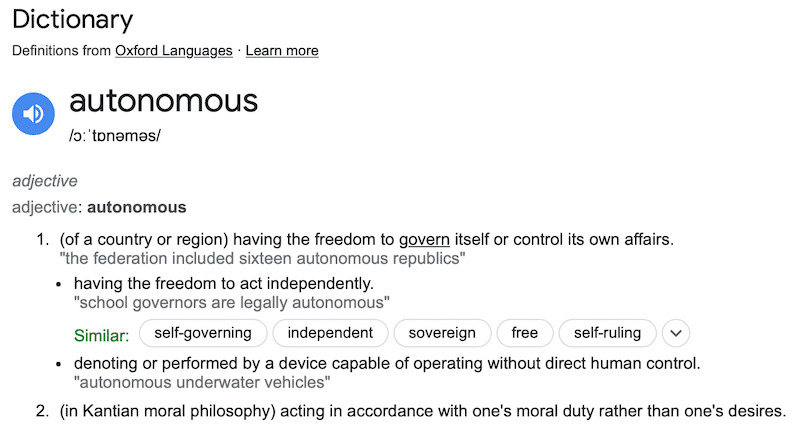Imagine a world where AI and machine learning work together seamlessly to plan and deliver effective marketing campaigns while eliminating human involvement. No more marketing analysts, no more copywriters, no more content creators. Instead, you’ll have an advanced technology that appears to have a brain of its own. It’ll continuously learn and adapt to changing consumer behaviour and optimise your campaigns right in front of you. Sounds futuristic, right? Well, it isn’t. The age of autonomous marketing where marketing AI seamlessly integrates with machine learning is here and it’s shaking up the marketing landscape.
Defining autonomous marketing
Autonomous marketing systems (AMS) use advanced technologies such as artificial intelligence (AI) and machine learning (ML) to self-manage and adapt to the environment. The term “autonomous marketing” is often used interchangeably with “self-driving cars” and “autonomous driving,” and it’s easy to see why. In simple terms, autonomous marketing is the use of predictive capabilities to engage with customers in real-time and hyper-personalise their experiences with content, data-driven recommendations, fulfilment and even follow-up to meet their needs.

By analysing customer data, AI can identify trends and patterns in your consumer behaviour and use that information revolutionising product selections for them perpetually. It’s important to make the distinction that “autonomous” means “completely, totally and utterly free of any human involvement whatsoever.” While smart AI algorithms, and marketing automation, are at the forefront, it’s ultimately up to you, as the marketer, to make the transition, and an early adoption, essentially Diffusion of innovation theory.
Why autonomous marketing is essential
Think about Facebook, and Google, their sophisticated algorithms that analyse billions of user data and behaviours. Without AI technologies, marketing as a whole is incomplete. Without them, you simply can’t keep up with the speed of your buyers and markets.
Here’s how Deloitte put it;
“Autonomous marketing is the use of predictive capabilities to hyper-personalise customer relationships in real-time with content, offering data-driven recommendations, fulfilment, and even purchase follow-up that anticipate people’s needs.”
Let’s take a look at some interesting facts about AI and marketing.
1. The global market revenue for AI in marketing is expected to reach more than $107,5 billion in 2028.
2. More than 40% of business-to-business (B2B) marketers plan to try or incorporate AI automation into their marketing plans.
3. 80% of industry experts (out of 100) incorporate some form of AI into their digital marketing strategies.
4. 67% of marketers say that the adoption of artificial intelligence (AI) and automation is the key to winning and keeping customers.
So, autonomous marketing, powered by AI, is no longer just a choice, but a strategic investment.
AI autonomy enables you to improve customer experience
The ultimate objective of all your marketing efforts is to enhance your customer experience, regardless of whether you have a one or one-thousand-person audience. Autonomous AI is one way to achieve this goal. According to VentureBeat, autonomous artificial intelligence is “a set of routines designed to enable robots, vehicles, aircraft and other devices to carry out long sequences of operations without human input.” The UK Government define it as “little or no human involvement”.
In the marketing space, autonomous AI agents are used to produce content, execute ad campaigns, anticipate industry changes, and provide personalised customer journeys. But their value doesn’t end there. Autonomous AI agents empower you to make informed decisions in unpredictable scenarios, allowing your strategies to adjust to changes quickly and efficiently.
Autonomous vs automated marketing: They’re not the same
Automated systems are not context-aware and are specifically told what to look for. In contrast, autonomous systems have a built-in learning model and feedback loop and are told what to look at.
Marketing automation
Marketing automation is a set of tools and technologies used to streamline online marketing processes and automate repetitive processes. It requires a human to manage it. Automated marketing is the predecessor of autonomous marketing systems, desperately trying to hang on. You’ve probably heard of automation platforms like Hubspot, Mailchimp or even Salesforce. These platforms allow you to plan, monitor, and analyse daily marketing activities
- Customised ad targeting and retargeting.
- Create, publish, and manage all types of digital content (blogs, videos, and social media posts).
- Lead generation, nurturing, and scoring.
Autonomous Marketing
Autonomous marketing is the use of predictive analytics via machine learning to personalise customer relationships in real-time with content, [data-driven] recommendations, fulfilment, and even purchase follow-up that anticipate people’s needs.
The distinction between Autonomous and Automated Marketing lies in their intelligence and flexibility. Autonomous marketing systems have a higher level of cognitive ability and flexibility because they learn from complex situations all the time. Automated marketing, on the other hand, follows a set of pre-defined rules and workflows. It relies on human intervention to adjust to dynamic situations, but it doesn’t have the flexibility to deviate from those functions. Autonomous marketing can learn and adjust based on experience.
There is now AI marketing software that does this, of course. It’s just an example of how things keep evolving. But if technology keeps going at its current pace, here’s what marketing assistants will look like in the future: An AI-enabled marketing assistant that goes beyond simple task automation. It can not only provide actionable insights, so still necessary to implement the necessary steps to affect the result. It can make intelligent decisions, identifying exactly what an individual consumer is most likely to buy next, and when, and deliver an email with that person’s hyper-personalised product selection email to effect the greatest response. It can adapt based on real-time data and analysis. As the retailer all you need to do is install the solution.
The Benefits of Hyper-Personalisation
Today’s consumers expect brands to use data to understand their needs, wants and desires and fulfil them with highly personalised experiences.
Hyper-personalisation, particularly when paired with predictive machine learning analytics, has the following benefits:
Increased engagement: Consumers are more likely to engage with personalised email messages that are relevant to their interests. More importantly, it is the only solution capable of putting your products in front of the specific individual at the perfect time. You don’t have to wait for a website visit on a Friday.
Improved conversions: Hyper-personalised content and recommendations drive higher conversion rates sustainably.
Enhanced customer loyalty: By demonstrating deep customer knowledge, brands can foster stronger relationships, increase overall customer satisfaction, and lead to increased customer loyalty.
Reduced cart abandonment: By providing personalised product recommendations and offers, brands can address common pain points such as consumer confusion or price sensitivity, which can reduce cart abandonment rates and improve conversion funnels.
Optimise marketing spend: By addressing each individual with their own unique targeted messages, you can optimise your marketing spend and allocate your resources more effectively, maximising the ROI of your campaigns.
Provide a competitive advantage: By offering hyper-personalised experiences, you set yourself apart from your competitors, positioning you as a leader in customer centricity and innovation
Provide scalability and scalability: With hyper-personalisation, you can scale up and down as your customers’ needs change and market trends evolve, ensuring that your hyper-personalisation strategies remain relevant and effective over time.
Reduce customer acquisition costs: By targeting individuals who are most likely to convert based on their past behaviour and preferences, you can reduce your customer acquisition costs while increasing your ROI for your marketing efforts.
Massive reduction in campaign overheads: By the mere fact that human beings are no longer engaged in any activity whatsoever, hyper-personalisation delivers much higher marketing ROI, which means that calculations for CPA are so negligible as to make it a redundant KPI. Hyper-personalisation strategies to Drive Ecommerce KPIs will be standard practice.
See this crucial software comparison article:
Distinctions between all the top hyper-personalisation software providers (Updated)





